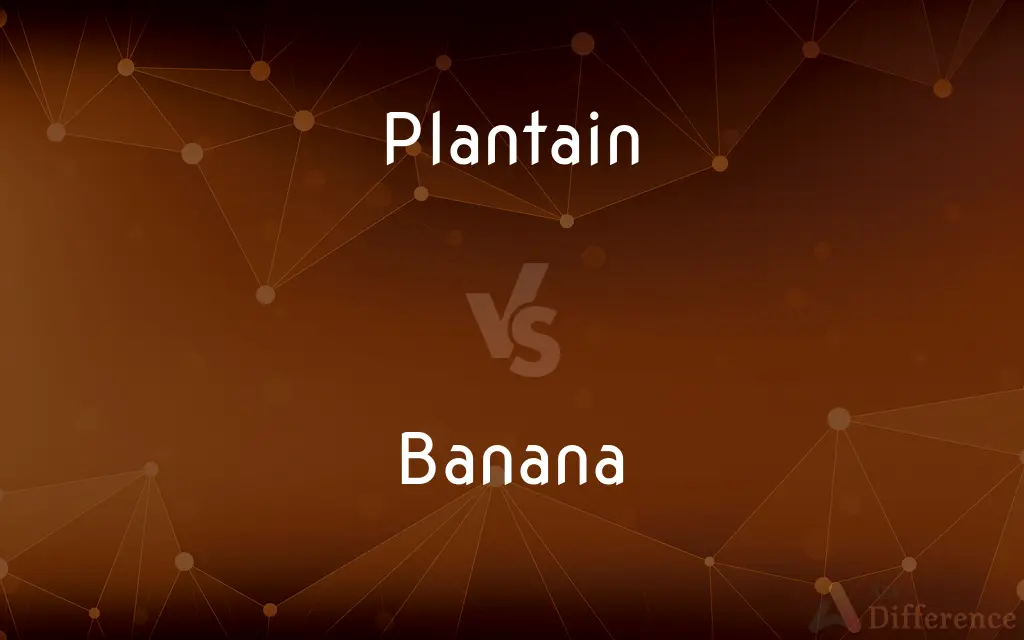Plantain vs. Banana — What's the Difference?
By Maham Liaqat & Fiza Rafique — Updated on March 26, 2024
Plantains are starchy, less sweet, and typically cooked before eating, often used in savory dishes, while bananas are sweet, soft, and consumed raw, favored as a fruit or in desserts.

Difference Between Plantain and Banana
Table of Contents
ADVERTISEMENT
Key Differences
Plantains, belonging to the banana family, are starchy and less sweet compared to their banana counterparts. They are usually green or yellow and become sweeter as they ripen, though they remain firmer and are commonly cooked before consumption. Bananas, on the other hand, are typically yellow when ripe, soft, and sweet, making them a popular raw snack or dessert ingredient.
While plantains are a staple in tropical regions' cuisines, often fried, boiled, or baked in savory dishes, bananas are universally consumed as a sweet snack or used in baking and smoothies. This distinction highlights the culinary uses and cultural significance of each fruit, with plantains often associated with main dishes and bananas with sweet treats.
In terms of nutritional content, plantains provide a rich source of complex carbohydrates, vitamins, and minerals but are lower in sugar content than bananas. This makes them a filling and nutritious component of meals. Bananas are known for their high potassium content and quick energy boost, thanks to their higher sugar content.
The texture of plantains and bananas also differs significantly. Plantains have a dense, tough texture that softens with cooking, making them suitable for a variety of cooking methods. Bananas' soft, creamy texture makes them ideal for raw consumption or as an ingredient in smoothies, cakes, and other desserts.
Cultivation and harvesting practices show some differences too. Plantains are typically harvested while green and underripe, ensuring they retain their starchiness. Bananas are harvested when they're still slightly underripe but are left to ripen until yellow and sweet. This reflects each fruit's intended use, whether for cooking or immediate consumption.
ADVERTISEMENT
Comparison Chart
Sweetness
Less sweet, starchy
Sweet, high sugar content
Consumption
Cooked (fried, boiled, baked)
Consumed raw or used in desserts
Culinary Uses
Savory dishes
Sweet snacks, desserts, smoothies
Nutritional Value
High in complex carbs, vitamins, minerals
High in potassium, suitable for quick energy
Texture
Firm and dense, softens with cooking
Soft and creamy
Harvesting Time
Harvested green, retains starchiness
Harvested slightly underripe, ripens to yellow
Compare with Definitions
Plantain
Less sweet and more firm than bananas.
Even when ripe, plantains maintain a firm texture, making them ideal for savory dishes.
Banana
Universal fruit, consumed in various forms.
From banana bread to fruit salads, bananas are a versatile kitchen staple.
Plantain
A starchy fruit similar to bananas, usually cooked before eating.
Plantains are a versatile ingredient, often fried for a crispy snack.
Banana
A sweet, soft fruit consumed raw or in desserts.
Bananas are a popular choice for breakfast smoothies due to their sweetness and texture.
Plantain
Rich source of carbohydrates and vitamins.
Plantains contribute significantly to the dietary fiber intake in many diets.
Banana
Ideal for desserts and sweet snacks.
Mashed bananas add moisture and natural sweetness to cakes and muffins.
Plantain
Common in tropical regions' cuisines.
In Caribbean cooking, plantains are as staple as rice and beans.
Banana
Harvested slightly underripe, ripen to yellow.
Bananas are shipped green and ripen during transport to grocery stores.
Plantain
Typically used in savory dishes.
Plantains can be mashed, boiled, or fried to accompany a variety of main courses.
Banana
Known for their high potassium content.
Athletes often eat bananas for a quick energy boost and to replenish electrolytes.
Plantain
A low-growing plant that typically has a rosette of leaves and a slender green flower spike, widely growing as a weed in lawns.
Banana
A banana is an elongated, edible fruit – botanically a berry – produced by several kinds of large herbaceous flowering plants in the genus Musa. In some countries, bananas used for cooking may be called "plantains", distinguishing them from dessert bananas.
Plantain
A banana containing high levels of starch and little sugar, which is harvested green and widely used as a cooked vegetable in the tropics.
Banana
Any of several treelike plants of the genus Musa, especially M. acuminata, having a terminal crown of large, entire leaves and a hanging cluster of fruits.
Plantain
The plant which bears the plantain.
Banana
The elongated, edible fruit of these plants, having a thick yellowish to reddish skin and whitish, pulpy flesh.
Plantain
Any of various plants of the genus Plantago, having a basal rosette of leaves and dense spikes of small greenish flowers.
Banana
An elongated curved tropical fruit of a banana plant, which grows in bunches and has a creamy flesh and a smooth skin.
Plantain
Any of several varieties of banana, especially Musa ×paradisiaca, having edible, starchy, elongated fruit.
Banana
In particular, the sweet, yellow fruit of the Cavendish banana cultivar, which may be eaten raw, as distinct from e.g. a plantain for cooking.
Plantain
The fruit of this plant, usually eaten cooked.
Banana
The tropical tree-like plant which bears clusters of bananas, a plant of the genus Musa (but sometimes also including plants from Ensete), which has large, elongated leaves.
Plantain
A plant of the genus Plantago, with a rosette of sessile leaves about 10 cm (4") long with a narrow part instead of a petiole, and with a spike inflorescence with the flower spacing varying widely among the species. See also psyllium.
Banana
(uncountable) A yellow colour, like that of a banana's skin.
Plantain
A plant in the genus Musa, the genus that includes banana, but with lower sugar content than banana.
Banana
A person of East Asian descent, especially an ethnic Chinese from a Western country who does not speak Chinese and only speaks English, considered to have overly assimilated and to be subservient to white authority, an East Asian race traitor.
Plantain
The fruit of the plant, usually cooked before eating and used like potatoes.
Banana
(sports) A banana kick.
Plantain
A treelike perennial herb (Musa paradisiaca) of tropical regions, bearing immense leaves and large clusters of the fruits called plantains. See Musa.
Banana
(nuclear physics) A banana equivalent dose.
Plantain
The fruit of this plant. It is long and somewhat cylindrical, slightly curved, and, when ripe, soft, fleshy, and covered with a thick but tender yellowish skin. The plantain is a staple article of food in most tropical countries, especially when cooked.
Banana
A catamorphism (from the use of banana brackets in the notation).
Plantain
Any plant of the genus Plantago, but especially the Plantago major, a low herb with broad spreading radical leaves, and slender spikes of minute flowers. It is a native of Europe, but now found near the abode of civilized man in nearly all parts of the world.
Banana
Curved like a banana, especially of a ball in flight.
Plantain
Any of numerous plants of the genus Plantago; mostly small roadside or dooryard weeds with elliptic leaves and small spikes of very small flowers; seeds of some used medicinally
Banana
A perennial herbaceous plant of almost treelike size (Musa sapientum); also, its edible fruit. See Musa.
Plantain
A banana tree bearing hanging clusters of edible angular greenish starchy fruits; tropics and subtropics
Banana
Any of several tropical and subtropical treelike herbs of the genus Musa having a terminal crown of large entire leaves and usually bearing hanging clusters of elongated fruits
Plantain
Starchy banana-like fruit; eaten (always cooked) as a staple vegetable throughout the tropics
Banana
Elongated crescent-shaped yellow fruit with soft sweet flesh
Common Curiosities
Are bananas or plantains better for you?
Both have their nutritional benefits; plantains offer complex carbs and vitamins, while bananas provide quick energy and potassium, making them both healthy in different contexts.
How do you know when a plantain is ripe enough to cook?
A plantain is ripe enough to cook when it turns yellow and softens slightly, though it can be cooked at any stage of ripeness for different flavors and textures.
Are there any dishes where both plantains and bananas are used?
While not common, some dessert recipes might use both for contrasting flavors and textures, highlighting their unique qualities.
Are plantains and bananas the same?
No, plantains and bananas are related but differ in sweetness, texture, and culinary uses, with plantains being starchier and typically cooked.
Can plantains be used in desserts like bananas?
Yes, ripe plantains can be used in desserts, though they lend a different flavor and texture due to their starchiness.
What's the best way to cook plantains?
Plantains can be fried, boiled, baked, or grilled, with the method often depending on the dish and the ripeness of the plantains.
How does ripeness affect the taste and texture of plantains and bananas?
For plantains, ripeness decreases starchiness and increases sweetness; bananas become softer and sweeter as they ripen.
Can you eat plantains raw?
While it's possible to eat ripe plantains raw, they are usually cooked due to their starchy texture and less sweet taste.
What are the main nutritional differences between plantains and bananas?
Plantains are higher in carbohydrates and vitamins but lower in sugar, while bananas are known for their high potassium content and quick energy from sugars.
Is there a difference in the way plantains and bananas are grown?
Cultivation practices are similar, but plantains are harvested green to maintain their starchiness, while bananas are allowed to ripen to develop sweetness.
Why are bananas more commonly eaten raw than plantains?
Bananas are sweeter and softer when ripe, making them more enjoyable to eat raw, whereas plantains' starchiness and firmer texture are enhanced by cooking.
How do cultural cuisines differ in their use of plantains versus bananas?
Plantains are often used in savory dishes in tropical regions, whereas bananas are favored in sweet dishes globally.
Can you substitute bananas for plantains in recipes?
Substituting bananas for plantains can significantly alter a dish's flavor and texture due to their differences in sweetness and starch content.
What makes plantains suitable for savory dishes?
Their starchiness and less sweet flavor profile make plantains versatile for a range of savory dishes, from fried snacks to stews.
Share Your Discovery

Previous Comparison
For vs. Fore
Next Comparison
Violet vs. MauveAuthor Spotlight
Written by
Maham LiaqatCo-written by
Fiza RafiqueFiza Rafique is a skilled content writer at AskDifference.com, where she meticulously refines and enhances written pieces. Drawing from her vast editorial expertise, Fiza ensures clarity, accuracy, and precision in every article. Passionate about language, she continually seeks to elevate the quality of content for readers worldwide.
















































